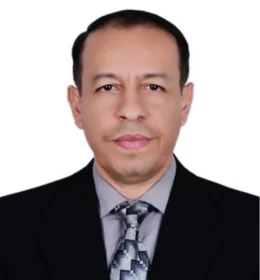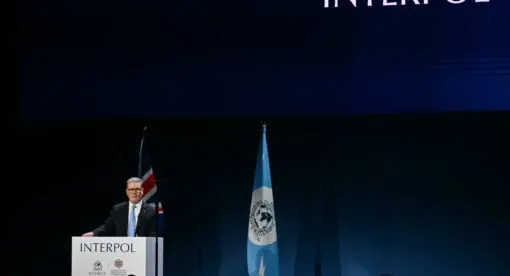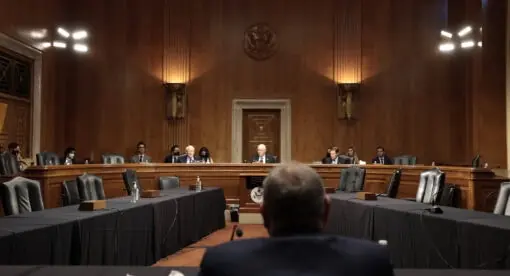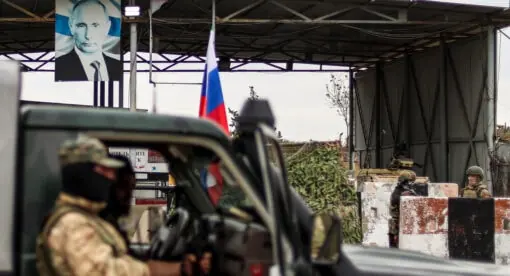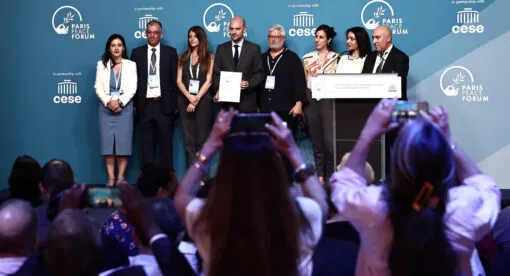In this Contours episode, host Carolyn Moorman talks with Senior Nonresident Fellow Chaouki Ghenai about the challenges, benefits, and emerging opportunities presented by increasing green energy connectivity between Africa and Europe.
Carolyn Moorman:
Hello and welcome to the Newlines Institute for Strategy and Policies Contours podcast. This is your host, Carolyn Moorman, and today we’ll be discussing the intersection of green energy and the African European relationship. I’m joined by non-resident fellow Chaouki Ghenai, who alongside myself is the co-author of a recent publication titled North African Renewable Energy Possibilities for Europe. At Newlines, Chaouki also oversees new energy initiatives, including future and innovative energy technologies, geopolitics of energy transformation, clean energy financing, new energy policy and sustainable energy in society. He has more than 25 years of research experience in energy field and management of clean energy research programs and research funding at universities, including the University of Sharjah, Florida Atlantic University and University of California, Los Angeles.
Chaouki, thank you so much for joining me. To get us started, I’d like to frame this conversation through how Europe and Africa have already developed a relationship based on energy, mostly conventional energy, and how you see this having the potential to be transitioned over into renewable energy. How can these two realms of conventional and renewable energy be framed in the African European relationship thus far?
Chaouki Ghenai:
Thank you so much, Carolyn. It’s really a pleasure to be here today with you to discuss this kind of energy collaboration or partnership between Europe and Africa, for both the conventional fossil fuel or oil and gas trade, and also clean energy technologies. So let’s start. As you know, oil and gas trade between Europe and Africa has been a significant aspect of their economic and energy relation. Europe is a major consumer of energy while several African country, particularly those in North Africa and West Africa, rich in oil and gas resources. So if you take some example of North Africa, I think Algeria, Libya and Egypt in North Africa have been historically supplying natural gas to Europe country, contributing to Europe energy security. Algeria, in particular, has been a major supply for natural gas to Europe through pipeline going through Italy and Spain.
Another example is Libya. Libya has been a significant exporter for both oil and natural gas, with maybe more oil to European market. However, political instability and conflict in the region have, at times, disrupted the production and export to Europe. For the Western African countries, mainly for the oil export, I can name here, for example, Nigeria and Angola. So these are two major oil producer. They export crude oil to international market, including Europe, which relies on import to meet the demand.
So if we can focus on the oil and gas trade before we talk about clean energy. The trade in oil and gas has been an important element of the relationship between Europe and Africa. And the discussion and debate have long been taking place regarding effort that try to create energy ties between the two continents. And there are so many factors here that will contribute to this collaboration. I will just mention a few of them.
The first one is the oil and gas exploration. Some African country possess a significant oil and gas reserve and there are so many European companies have been involved in the exploration and extraction project in the region. The second important factor for this kind of partnership is the energy import to Europe. So Europe is a major consumer of oil and gas and African countries, especially those in North Africa, play a role is supplying hydrocarbon to meet European needs.
So I will just give you some numbers here. For example, if you look for Europe’s LNG (liquefied natural gas) import in 2022, you can see, from the top six countries that exported LNG to Europe, you can find three African countries. Say Algeria was number four after USA, Qatar and Russia with 12.2 billion cubic meter of natural gas going to mainly Spain, Italy, France, Turkey, and UK. Nigeria was on number five with 11.62 billion cubic meter, and Egypt was number six with 9.67 billion cubic meters. So from this three country you can see two from North Africa and one from West Africa. With respect to the oil, the share of oil imported into European Union also from Africa, in 2021, for example, it was 18% coming from three countries: Libya, Nigeria, and Algeria, with Libya with 8%, Nigeria, 7%, and Algeria, 3%.
So as you can see clearly, I think, the oil and gas trade between African country and European countries. But one important parameter here is the infrastructures. Because I mentioned at the beginning, that there are so many reserves on oil and gas from Africa that we need investment in infrastructure such as pipeline and liquefied natural gas, LNG terminals to facilitate the transportation of this oil and gas resources from Africa to Europe. Yes, we have several natural gas pipeline that exists in North Africa for the transportation of this natural gas from Africa to Europe.
And so we can mention for example, the Maghreb-Europe gas pipeline going from Algeria to Spain via Morocco. Another pipeline transmit Algeria to Italy via Tunisia. Another one is the Medgaz pipeline from Algeria to Spain. So this will provide additional route for Algerian gas export to European Union. And there are new projects, proposed projects. The first one, Trans-Saharan gas pipeline going from Nigeria to Algeria and the second one, Nigeria to Morocco. So these are proposed project to increase the capacity of exporting natural gas from Africa to Europe. There are, of course, some challenges and opportunities for this trade. The first one, geopolitical consideration, infrastructure constraint, market dynamic price fluctuation, global energy transition, which is an environmental concern to reduce the greenhouse gas emissions. And we have to reduce a little bit the energy consumption, I think, from fossil fuel and diversification effort.
See, that’s why European country are exploring where to diversify their energy sources to enhance the energy security. This may include seeking alternative supplier and investing in renewable energy project. See, there is an increasing focus on collaboration or renewable energy project between Africa and Europe and this is mainly to different factors. The first one is energy security and diversification. So Europe is actively seeking to diversify its energy sources to enhance the energy security, reduce the dependency on single region. Africa, with its abundant renewable energy potential and hydrocarbon resources present an opportunity for collaboration.
So there are so many examples, for example, Algeria, Morocco, Tunisia, they have plenty of solar and wind resources that can be used to produce renewable energy and produce renewable electricity and the excess electricity can be exported to Europe, for example, or maybe produce low carbon fuel like green hydrogen and green ammonia that can be exported to Europe.
So there are so many opportunity for renewable energy collaboration, for energy access and electrification, especially for Africa, using renewable resources. But we need also some investment of financing. European country may provide investment and financing for energy infrastructure in Africa for fostering this economical grow and development in Africa and also European country. There is also another factor which is climate change mitigation. Collaboration is needed to address the climate change concerned by promoting clean energy technologies.
And so there are so many projects, I think collaboration on clean energy technologies relate to renewable energy like solar PV, wind, biofuel, green hydrogen, green ammonia joint project and also, as I said, we need some grants and loans maybe established to facilitate this implementation of this sustainable energy project between Africa and Europe.
Carolyn Moorman:
So you mentioned a lot of really good aspects for us to consider there and I want to pinpoint a couple of them, mainly, how we should consider the role of geopolitics playing into energy sharing and energy collaboration between Europe and West Africa and even North Africa. So you mentioned two projects, that we also mentioned in our piece, that are in process, which is the Nigeria, Morocco gas pipeline that is planned to be transporting Nigerian gas through a plethora of West African states to Morocco to then go to Europe, and then also, the Trans-Sahara gas pipeline, which is planned to go from Nigeria to Niger, to Algeria, again, with the whole goal of transporting liquefied natural gas to Europe. And the instability that is currently affixing some of these countries, mainly, as we mentioned in the piece, Libya, Nigeria, even Niger to a certain extent, limits the role and the possibility of long-term European dependence on these very big fossil fuel suppliers, producers.
So when we look at Nigeria and both Libya and the amount of production in capacity they currently have, in comparison to how big of reserves and capacity they could have. And as you mentioned, again, this plays into the role of these countries needing infrastructure, but with the insecurity, both security and political wise in these countries, this kind of leans into the argument of Europe better putting its infrastructure to meet its climate change goals, to meet its goals in regards to the use of clean energy into producing infrastructure and producing the capacity of these countries to make natural and green energy like green hydrogen.
And when we even look at, as I mentioned, this Nigeria-Morocco gas pipeline and the Trans- Sahara gas pipeline that are currently planned to go through multiple West African countries, including Niger, which as we all know, faced a very destabilizing coup in late July of 2023 that has caused a lot of security ramifications for the Sahel that is currently dealing with a very, very insurgent jihadist problem. And all of this, as I just said, reframes the importance of Europe looking at more renewable energy sources and brings us to our second point of the piece, which is the use of green hydrogen. And so, Chaouki, as we know, green hydrogen represents a form of energy that is able to be made through renewable energy sources and thus, contributes less to climate change and is better for the environment. But I’m wondering if you can explain a little bit more about how green hydrogen is produced and how this represents an alternative kind of energy source figure up. And then, along those lines, what technical and energy-related roadblocks exist for the utilization of this energy source?
Chaouki Ghenai:
Yes, thank you so much. Yes, green hydrogen as you mentioned, is a hydrogen that is created via procedures or steps that use renewable energy sources such as solar, wind or hydropower. So how it works is, by splitting the water molecules into hydrogen and oxygen through a process known as electrolysis by generating hydrogen without the carbon emission that are often created by conventional process. Because the process that we’re using to produce hydrogen, which is mainly used at maybe 90, 95% of the hydrogen produced worldwide, is using fossil fuel, which is steam methane reforming such as natural gas reforming. And this approach can produce CO2 emissions. So if we capture the CO2 from this steam methane reforming, we call it blue hydrogen. So you’re using fossil fuel to produce hydrogen, you are capturing the CO2. But green hydrogen, you are producing it using renewable electricity.
So this makes the entire process of producing hydrogen environmentally friendly. This renewable resources ensure that hydrogen produces is carbon free and contribute to the low carbon energy system. What’s good about this green hydrogen, it can be used for different applications, especially, we’re talking about collaboration between Africa and Europe. Say, it has a lot of application, you can use it in fuel cell to produce electrical power. This is what we call a repowering. It can be used for industrial application, particularly in a sector that are challenging to decarbonize using other methods. It can be used for transportation as hydrogen fuel cell for example, to power vehicles. It can be used for residential, commercial building, maybe for heating, even maybe the price is a little bit high to other technologies, and it can be used also as an energy storage. You can store the hydrogen and you can be integrated with grids, for example, for intermittent resources. The solar or wind, if you use them to produce electrical power, you need a storage system. Either you can use the battery or you can use a hydrogen as energy storage.
So the green hydrogen as an alternative fuels have gained significant attention in Europe as part of the region commitment to decarbonize its energy system and reduce the carbon footprint. The European Union has launched a European hydrogen strategy, aimed at developing hydrogen infrastructure to create a market for green hydrogen. European country engaged in energy diplomacy to secure also sustainable energy sources and technologies. There is ongoing development, policy adjustment and technology advancement which will likely shape the future of landscape of alternative fuel in the region, both in Africa and Europe. We’re talking about green hydrogen, maybe also green ammonia and also, what we call, electro fuel. This is synthetic methane or synthetic methanol that we can produce from hydrogen.
But the key point regarding this potential Africa, Europe green hydrogen partnership will include, the most important part, is the renewable energy resource that are available in Africa. I can mention Algeria and Morocco as an example, and Tunisia, but the resources, the renewable resources that are available in Africa are not available in Europe. So there are a huge potential of solar and wind resources that can be used in Africa to produce a renewable electricity and produce this alternative fuel like green hydrogen and green ammonia that can be exported to Europe for both green hydrogen ammonia and also electricity.
Hydrogen also, is an energy carrier. It can be used for different application, as I mentioned before, but we need for that infrastructure development. So we need a joint effort to develop the necessary infrastructure, including electrolysis facilities to produce electrolyzer. The storage, we need to develop hydrogen and ammonia storage technology and also, the transportation network, if we’re talking about exporting this hydrogen and ammonia from Africa to Europe. So we need also to encourage the investment and financial support for green hydrogen project in both Africa and Europe for energy transition goals for both Africa and Europe. Because we are talking, we just finished at the COP28, we were talking about net zero emission by 2050. So you’re developing clean energy technology, you are talking about zero carbon fuel that will help to reach the goal by 2050 for both Europe and Africa.
There are some international initiative. I will mention, for example, European Green Deal. So the European Green Deal includes strategies for developing hydrogen economy and fostering international partnership to ensure and secure a sustainable energy supply. Since we’re talking about initiative, this is a good example of partnership between Africa and Europe, where they can work together to, for example, produce renewable electricity using the renewable resources in Africa to produce electricity and use it to produce hydrogen and ammonia and export this clean energy to Europe. African Union agenda, also, if you look for the African Union agenda by 2063, they look for sustainable development and could provide a framework for collaboration with Europe on green hydrogen and for economical development also for both Africa and Europe. Green hydrogen project can contribute to economical development, job creation, technology transfer in both Africa and Europe.
At the end, I want just to mention, because you’re talking about the challenges, the first challenges that we have with the green hydrogen, is the cost. As of now, the cost of producing green hydrogen is relatively high compared to hydrogen produced from fossil fuel, the steam methane reforming. However, ongoing advancement and increased scale are expected to drive the cost down in the future. So we need to do more research to improve the efficiency of converting this, splitting this water in the electrolyzer to produce hydrogen oxygen and also scale up. And this will help to reduce the cost.
The second problem that we have, especially, we’re talking about collaboration in green hydrogen between Africa and Europe, is the infrastructure. So we need the development of infrastructure, including hydrogen production facilities, the storage and distribution network. It is essential for the widespread adoption of green hydrogen. We need also clear strategy investment to promote hydrogen production and use, for example, from African countries. We need the private sector engagement to boost this energy transition and also to boost the hydrogen economy. And we need also, some government support, need more government support to provide financial incentive, subsidies and framework to encourage the development of green hydrogen project in Africa.
Carolyn Moorman:
Absolutely, and I think it’s also important to recognize these roadblocks that exist geopolitically, in terms of limiting, or at least, in terms of appearing to limit the potential of partnership between particularly, those North African countries that have a really good potential for green hydrogen and Europe. In the piece, we talk about Morocco and Algeria as being great examples of countries that can contribute to this green energy initiative because of their abundant hydro, wind and solar power and also, the precedent that we’ve seen Europe already start to turn towards these countries for this reason. Yet, I think it’s also important to recognize potential inhibitors of this partnership, particularly, the Moroccan-Algerian struggle over the Western Sahara. This of course, is the region in western Africa that has particularly always been a point of tension between Morocco and Algeria. And this was made worse by the Trump administration’s decision to recognize the Moroccan claim to the territory in 2020, due to Morocco’s recognition of Israel in the Abraham Accords. Algeria, of course, supports the pro independence police area [inaudible 00:19:15]. And then also, we have to consider Algeria’s historical bend towards Russia.
But all of this said, in the piece, we deem green hydrogen as too great of a benefit to Europe to ignore for policymakers. And we’ve seen already, that these obstacles can be overcome and have been overcome. We’ve seen multiple countries target both Morocco and Algeria and been able to successfully make yields towards the establishment of green hydrogen production together. Germany, in 2020, signed an agreement to work towards green hydrogen production with Morocco and then also, has pledged an initial $300 million investment to the Algerian government or has connected with the Algerian government by having its development bank plan to invest in Algeria’s green hydrogen industry. And so here, we see a perfect example of this struggle over the Western Sahara being important, of course, but green hydrogen being able to rise above this and play into Europe meeting its 2050 goals and just both continents being able to lean more towards recognizing the role of climate change and doing better things for the environment.
And then also, in terms of Algeria’s bend towards Russia, this is of course, something that plays into Algerian foreign policy. Russia is very important to Algeria’s security posture, to how it behaves in international mechanisms such as the UN. But I think it’s also important to recognize here how Algeria has, to a certain extent, as some would argue, tried really hard to play to act in a neutral manner, particularly, in regards to the Russian invasion of Ukraine in 2022. And we’ve seen this particularly, through how Algeria has engaged in the U.N. And I think, this can frame how the international community, particularly Europe and the U.S., can look towards Algeria being a really good target for collaboration between Europe and Africa for green energy production because again, there is that precedent there.
So, to end, Chaouki, I’m wondering how, we’ve talked about how this is a really good place for Europe to invest more heavily, more cohesively behind African infrastructure for green energy and renewable energy. But I’m wondering, how can U.S. policymakers support this effort beyond what we argue in the piece, as publicly standing behind European investments to encourage more investments. You mentioned the important role of the private sector in this process and the role of incentivizing the private sector, et cetera. And so I’m wondering if you could go into a little bit more detail about what U.S. policymakers can do here alongside European policymakers, and then also, what does the U.S. stand to gain from this kind of investment?
Chaouki Ghenai:
Yes, thank you so much. I think we’re talking about I think Africa, Europe, clean energy and green hydrogen collaboration. This is very important, I think, for the two continents. The United States policymaker have been actively supporting green energy and green hydrogen initiatives through a combination of legislative, regulatory and financial measures. So these initiatives are part of the broader effort to address the problem of climate change, environmental sustainability, and the transition to clean energy economy. So the United States can support Africa, Europe clean energy initiative through the various means or different means, fostering collaboration and contributing to development of sustainable and low-carbon energy system.
So I will mention some points here for what the United States can do. First of all, financial support. Since the United States can provide financial assistance, investment and funding for clean energy project in Africa and Europe, this support can help catalyze the private sector investment and facilitate the development of renewable energy infrastructure. The United States can help also with the expertise and the knowledge transfer. This is very important. Facilitating the transfer of clean energy technologies, the best practices, the expertise from the United States to Africa and Europe. This include training, program, workshop and collaborative research initiatives.
As I mentioned before, Africa, they have all the resources, solar, wind, it’s there. You can produce renewable electricity, you can produce green hydrogen, green ammonia that can be exported, can be used in Africa, of course, and it can be used also exported to Europe. But they need also expertise, knowledge transfer and capacity building. This is very important. Capacity building, we need assistance of the African European country in building the capacity to design and implement effective policies and regulation that promote clean energy development, for example. With respect to policy alignment, promoting also alignment of energy policy framework to create an enabling environment for cross-border clean energy initiative, encouraging also collaboration, promoting public private partnership between USA company, African nation and European country for joint ventures in clean energy project. Business matchmaking also, this will facilitate the connection between USA clean energy companies and project opportunity in Africa and Europe. Joint research initiative supporting collaborative research project between the USA research institution, African research organization and European counterparts to advanced clean energy technologies.
We’re talking about innovation hub. The United States already started green hydrogen hubs. Say, we need to work on establishing also innovation hubs or centers that brings together researcher, scientist, entrepreneur from USA, Africa and Europe. So this kind of hub will start also in Africa. So they need to use the same model that has been developed in USA to be transferred maybe to African countries, especially, North Africa. Investment in infrastructure. USA can help us or contribute to development of clean energy infrastructure, including renewable energy project, smart grid and energy storage facilities in Africa. Technical assistance providing technical assistance for planning and implementation of energy infrastructure project.
Another point which is very important, which is the workforce training. As I mentioned, Africa has all the resources, but it’s lacking the workforce training. Offering training programs to build the skills and the capacity of the workforce in Africa and also in Europe in area related to clean energy technology and project management is very, very important. Another important factor is education program. United States can help also, investing in educational program that focus on energy and environmental sustainability. This is very important. So through this collaboration effort, the United States can contribute to the advancement of clean energy initiative in Africa and Europe, fostering sustainable development, addressing climate change and promoting economic growth. Importantly, engagement should be based on mutual respect, shared goals and understanding of the specific needs and priorities of the region involved, especially in Africa.
And you mentioned also, what type of benefits the United States can get from this kind of collaboration between Africa and Europe. So the United States company specializing especially in renewable energy, energy storage and other clean energy technologies can access new markets in Africa and Europe through this collaboration leading to increase in export. The United States can offer United States investor opportunity for attractive returns. Diversification on long-term partnership with African countries and European country. USA companies involved in clean energy project may contribute to job creation, both domestically and internationally, supporting economical growth.
Another point, which is enhancing global leadership in clean energy technologies. So United States is taking the lead on green energy, renewable energy, green hydrogen, and this will enhance the global leadership of United States in clean energy. Another point is, it will contribute also to development of stronger diplomatic tiles and strategic alliances between the United States, African nations and European country. This is a very good opportunities, especially for USA to start this kind of project to develop stronger diplomatic ties with these African countries. Climate change and mitigation, this will help also to tackle the problem of climate change, reduce the global carbon emission.
Building global resilience, addressing energy challenges in Africa will contribute to building global resilience, fostering stability, and reducing geopolitical risks associated with energy access in Africa. And the last point that I want to mention, is the United States also can support for sustainable development because the sustainable development goal number seven state, we need to develop clean and affordable energy for all. So this will help also, to invest in this kind of clean energy technology in Africa. And also, it’ll help to address the energy poverty in Africa.
So these are some example of the benefits that the United States can get from this kind of collaboration between Africa and Europe, related to clean energy technologies.
Carolyn Moorman:
You made really great points, and I think, just to add a little bit, it would be also really important for the U.S. to consider this kind of investment in this kind of involvement in the European African green energy relationship as a potential to address larger geopolitical goals for the North African region and Algeria specific, which is in regards to great power competition and counter-terrorism. As I mentioned earlier, the Sahel directly to Algeria’s south is facing a rapidly expanding, very powerful jihadist insurgency. And that has faced a lot of issues in recent years, especially with the coup that, as I also mentioned, in Niger in July, 2023 and how the counter-terrorism force, the G-5, has kind of fallen apart. The French have faced a lot of problems continuing their counter-terrorism mission in the region, and Algeria is viewed by some, as a potential outlet to continue this counter-terrorism mission.
And although this involvement may range, may be broadened later in time, and it’s still something for U.S. policymakers to consider as a benefit of establishing a better relationship with the Algerian government through this kind of initiative, as an outlet to kind of engage more with Algeria in regards to counter-terrorism. And also, in regards to great power competition, as I mentioned earlier, Algeria has always been seen as in Russia’s orbit, and this has tended to be problematic for the North African Mediterranean region. And the U.S. has showed to be very in tune and to care a lot about how it is viewed in this region and to keep a strategic watch on how Russia and China operate in this Mediterranean zone and to have a better, as Chaouki just mentioned, a better relationship with the Algerian government and to rebuild ties that have been hurt in the past, such as by the Trump administration’s decision to recognize the Moroccan claim to Western Sahara.
This should all just be beneficial to that goal for great power competition and a counter-terrorism perspective. While it again, may not radically change the scenario, it will give the U.S. likely, a better eye into the Algerian government and a better chance to make strategic moves on these two issues that it considers very important.
Chaouki, I’d like to thank you so much for joining us on this episode. This has been a wonderful discussion. I’d encourage all of the listeners, if you’ve enjoyed this episode, to check out our publication at Newlines on this very topic. You can also check out further episodes of Contours wherever you get your podcasts, including SoundCloud, iTunes, et cetera. You can check out further analysis into geopolitics at www.newlinesinstitute.org. Thank you so much for listening.

